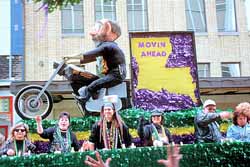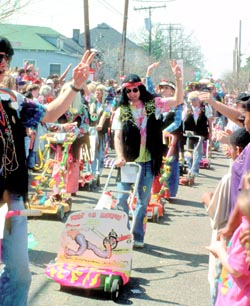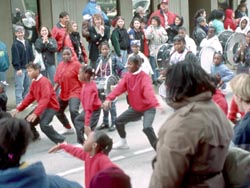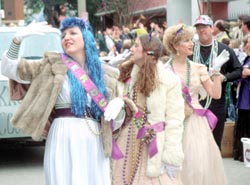It's a Very Pink Day in My Neighborhood
By Joceyln Hazelwood Donlon
What do you think of when you hear the words "pink flamingos?" The zoo? South America? Miami, Florida? Lawn ornaments? Gaudy clothes with flamingos all over them? Bad taste?!! Perhaps you've never even thought about pink flamingos.
When I hear "pink flamingos," I think of "Spanish Town," my historic, delightful, kind of quirky neighborhood in downtown Baton Rouge.
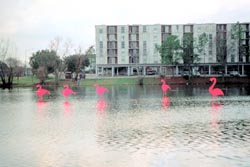
Spanish Town is historic because it is the oldest neighborhood in Baton Rouge. It was founded in 1805, two years after the Louisiana Purchase took place. Baton Rouge wasn't part of the 1803 Louisiana Purchase. Instead, it was part of the "Province of West Florida." West Florida included East and West Feliciana Parishes, East Baton Rouge, Livingston, St. Helena, St. Tammany, Tangipahoa, and Washington Parishes. Today, we call these the "Florida Parishes" because they have a different history from the rest of the State. The rest of Louisiana was purchased by the American government, but West Florida was owned by Spain. Many of the people in West Florida were Anglo; in other words, they had English ancestry, and they disliked having Spanish rule. They really wanted to be part of America rather than Spain. So they started a rebellion, which lasted until 1810, when they finally became part of the United States.
During these years of unrest, people from the Canary Islands settled along what is now called Spanish Town Road in 1805. The Canary Islands are located off the coast of Spain, near North Africa. Unlike Anglo residents of Baton Rouge, Canary Islanders enjoyed being part of Spain, since they had Spanish heritage. By living in "Spanish Town," the residents could keep their own identity, their Spanish language, and community.
Today, the neighborhood still has a unique sense of community—a sense of difference. To symbolize our difference from the rest of Baton Rouge, my neighbors and I have adopted the pink flamingo as our mascot. Why such an unusual mascot? Because our worldview is that "poor taste is better than no taste at all!" Some people think flamingos show poor taste!
Perhaps your own aesthetics—your sense of what is "beautiful" or "appropriate"—tell you that pink flamingos are "poor taste." After all, plastic pink flamingos have been decorating American lawns for many years. But these plastic flamingos are often called "kitsch" by American society. Kitsch is inexpensive stuff, mass produced, and considered by "cultured people" to be of "poor taste." Velvet paintings of Elvis Presley would definitely be considered kitsch by many people. But, remember, some people, with a different aesthetic, prefer kitsch! In Spanish Town, we really like kitsch.
People who live in Spanish Town are perhaps not the richest people in Baton Rouge. However, they are often interesting artists, writers, teachers, actors, and musicians. There are also politicians, lawyers, and doctors. And many college students rent apartments here. Spanish Town has a wide range of income-levels in the neighborhood, from quite poor to quite wealthy. You can see grand mansions next to shotgun houses. (A shotgun house is a small house that is one room wide, and several rooms deep. A door leads from room to room, so that if a person stands at the front of the house, he or she could fire a shotgun all the way through the house—from the front room to the back.) But nearly all of these houses display pink flamingos, symbolizing the neighborhood's unified and different sense of identity.
Indeed, we residents of Spanish Town want to be seen as different from the rest of Baton Rouge. We love our narrow little streets, our historic homes, and our diversity of people—even the unusual ones. We love our front porches, our many stray cats, our neighborhood grocery store. We don't care if someone's yard isn't "perfect." Our neighborhood tells others that we like to see ourselves as tolerant and diverse.
Today, Spanish Town is trendier than it was several decades ago. But a few decades ago, the neighborhood was thought by the rest of the city to be more "questionable." During this time the pink flamingo was adopted as the community mascot. In effect, this kitschy lawn ornament told the rest of Baton Rouge, "So what if you think we are `questionable'? That's better than being boring." Today, it is difficult to find a home or yard in Spanish Town that doesn't display some kind of flamingo. They're all over my house, porch, and yard, to be sure.
When you wander the narrow streets of Spanish Town, with its banana trees, crape myrtle trees, azalea bushes—and flamingos—you soon realize that you are in an urban center. Why? Because the neighborhood is at the foot of the New State Capitol in Baton Rouge. With this historic monument towering above our homes, we are reminded daily that we are in the Capital City of Louisiana. A stroll to the Capitol takes you near some of Louisiana's other historic sites: the Mississippi River, the Old State Capitol, and the Pentagon Barracks. When I have out-of-town guests, we especially like to visit the Capitol, so that we can find my house from the observation deck on the 24th floor.
The architecture of Spanish Town is, mostly, post-Civil War, though a few historic homes dating back to the early 19th century are still standing. The homes are typically early 20th century, made of wood construction. The houses usually have a large front porch, high ceilings, and wooden floors.
The heart of our neighborhood is Capitol Grocery on Spanish Town Road, our main street where the Canary Islanders originally settled. The small grocery store, owned by a resident, became an eatery several years ago. People gather there everyday to eat lunch, read a newspaper, have a cup of coffee, or just chat.
And it is along Spanish Town Road that our annual Mardi Gras parade rolls on the Saturday before Mardi Gras day.
Back in 1981, when the neighborhood was thought to be "questionable," the residents decided to "celebrate their difference" by starting their own Mardi Gras parade. The first parade rolled—or walked—along Spanish Town Road. Long-time residents say that the first parade was very small. In fact, they say that fewer than ten people lined the streets. Children were the marchers, and they banged on fruit cartons and threw a few beads. Then, the spectators would run to the next corner and throw the beads back to the marchers, so that the parade could continue. Today, many years later, the parade has grown to be so large that it almost seems too big!
Sarcasm and irony play a large role in this neighborhood parade. It is not intended to be "family oriented," though many children attend with their parents and have a great time. The parade is designed to mock people in positions of authority. Sometimes it is even a bit indecent. Ever since its second year, the parade has had a theme, and, typically, the theme allows the floats to make political commentary, or even to be "tacky." Some of the themes in the past have been:
- "Everyman a King" (1982)
- "Poor Taste is Better Than No Taste at All" (1986)
- "Louisiana's Dirty Laundry" (1992)
- "Politically Incorrect" (1998)
- "Louisiana Purchase: Name Your Price" (2003)
- "Flamingos Gone Wild" (2004)
Just use your imagination! Which Louisiana political figures do you think are mocked?
If you say Edwin Edwards, Bill Clinton, and George Bush, among others, you're right! The parade after September 11th used Osama Bin Laden as a target, as you can expect.
The very first parade theme in 1982 is especially important. You might remember that "Everyman a King" was Huey P. Long's slogan when he was governor in the 1930s. During these hard times of The Great Depression, Long claimed that all Louisiana citizens, no matter how rich or how poor, should have "a chicken in every pot." In 1982, when the parade organizers used "Everyman a King" for their theme, they were putting important political ideals in a different, impolite, context. (Sort of like belching in church!) That theme was especially meaningful because Mardi Gras is a time when ordinary people dress up as kings and queens—pretending to be "powerful people." Every Spanish Town Mardi Gras parade has a king and queen. The first year I attended, which was 1996, a dog was the king!
The more traditional Mardi Gras krewes of New Orleans have classical names, such as "Krewe of Rex," "Krewe of Endymion," or "Krewe of Bacchus." However, Spanish Town krewes have more playful, even impolite, names. The founding krewe's name is "Mystic Krewe for the Preservation of Lagniappe," and they are in charge of collecting the floats' entry fees. These fees are donated to the Louisiana Food Bank. This krewe originally adopted the pink flamingo as its symbol, which later became the symbol of the entire neighborhood.
Other groups are called "Wasted Krewe," "Krewe of Roadkill," "Krewe of Krime," "Krewe of Le Mouk," and "Krewe of Moulah," to name a few. Awards are given out for such honors as "Deepest Concept," "Best Ethnic Float," "Best Pleasing of Judges," and the "Best Bribe of Judges." Indeed, the bribing of judges is not only accepted but encouraged. There are also more typical awards of "Best Float" or "Best Music." Sometimes the judges are punished by krewes for their decisions. One year, a float threw water balloons at the judges' stand. However, the next year, the judges got revenge by throwing cream pies at that float.
The "Best Marching Group" award typically goes to the best known krewe of the Spanish Town Parade: The Krewe of Yazoo. This krewe is also known as "The Lawnmower Brigade." Each member of the dancing krewe pushes a lawnmower. Before the parade, each krewe member is required to decorate his or her lawnmower—a personal float—to reflect the krewe's theme. The marchers perform several complicated dance routines with their lawnmowers (which are not running, of course). They have, in the past, dressed up as "Cosmownots" and as roaches of a "Roach Mowtel." In 2004, they were dressed as trees, and their theme was "Krewe of Mow Return."
Every year, the best part of the parade for me—and for nearly everyone I know—is when the Lawnmower Brigade passes. In fact, when many people think about the Spanish Town Parade, they might first think of "flamingos," but they will often think of "lawnmowers" second.
As is traditional, there is a Mardi Gras ball preceding the Spanish Town parade. But, again, this ball is done with a difference.
The ball is first announced when the organizers place about 20 giant, plywood, pink flamingos in the lakes near LSU. It is very strange to be driving on Interstate 10 and see the flamingos nesting in the LSU lakes.
A long-time tradition (one which is becoming too popular, as far as I am concerned, because it is taking away from the residents' fun) is for residents of Spanish Town to "kidnap" a lake flamingo and "relocate" it to their own yard. I have talked about the many flamingos decorating lawns; but the most "treasured" flamingo is one of these giant lake flamingos that has been kidnapped and relocated.
I am sad to say that I have not yet kidnapped a flamingo for my yard. This year (2004), I had planned to do it. But all of the lake flamingos were kidnapped in less than 24 hours! I was out of town when the flamingos were placed in the lake, and by the time I returned—one day later—they were already gone. I was NOT happy!
But I digress.
Once the flamingos are put in the lake, the ball has officially been announced. The ball has grown to be so large that it is now held in a really large convention center. Originally, the ball was held in neighborhood homes, and the entrance fee was a canned good for the Food Bank. As the ball grew larger, it moved to the Varsity Theater (a place where rock concerts are held now), then to the Argosy Atrium—a bit larger than the Varsity—and now to the largest convention hall in Baton Rouge. Today, the fee is $25 to get in. Donations are still made to the Food Bank.
To attend the ball, people do not have to wear tuxedos and evening gowns. Instead, the dress is "costume" or "creative formal." In addition, people buy their tickets in advance, reserve a table, and then decorate their own table. Music is usually provided by a rock, blues, or Cajun band, and participants can even vote for their preferred music on the Internet.
After the ball, residents of Spanish Town begin preparing for the annual parade, which rolls at noon on the Saturday before Mardi Gras day. On the day of our parade, people who live in the neighborhood are expected—even obligated—to open their homes to friends, family, and some strangers. I always begin the day by cooking my traditional pot of red beans, which can serve about 30 people. My husband and I clean the house and decorate with all the flamingos we have collected throughout the years. The party stores in Baton Rouge have begun to see the economic value of stocking flamingo decorations, so we can now put out flamingo tablecloths, ceiling decorations, napkins, plates—even light bulbs!
My guests begin arriving at about 10:30 in the morning, and usually bring an item of food or drink to contribute to the party. One guest brings her traditional green salad; another brings a king cake; and others bring whatever is handy. My brother-in-law often fries a turkey.
Many guests arrive in costume, with pink being the dominant color. In fact, many parade-goers—over 100,000 people—costume in pink. People wear flamingo sunglasses, flamingo hats, flamingo shirts, flamingo shoes. I have a traditional pink flamingo sweater to wear.
At noon, we walk to Spanish Town Road for the parade, which, these days, lasts for two hours! We scramble for beads, laugh at the floats, criticize the floats that are "boring," dance to the music, and generally have all the fun that a person can have at a Mardi Gras parade.
After the parade has finished, friends drop in for an "open house" until about 5:00. And these friends will invite other friends. And these friends will invite other friends. And strangers—whom no one knows—will drop in. This year (2004), a stranger rode his bicycle into my living room, saying that he had heard about a house that wanted to give away its food! My husband told him that this was NOT true, but that he was welcome to eat a plate of food. It was a bit strange, to tell you the truth. But then, "strange" is the nature of the whole day.
By 7:00, my house is empty, my husband and I clean up, and we settle into another year of life until the Spanish Town Mardi Gras parade rolls around again.
In the meantime, people leave their flamingos in the yard, and beads hang from the trees and power lines to daily remind us that we are a different kind of neighborhood, with a unique "sense of place." Sometimes I worry that because the parade has grown so large, it will become too "bland," or boring, that it will have "no taste at all." But daily life in Spanish Town reminds me that we are about more than our parade. We are about our narrow streets, historic homes, and interesting people who make up our community. We are people who love pink flamingos.


